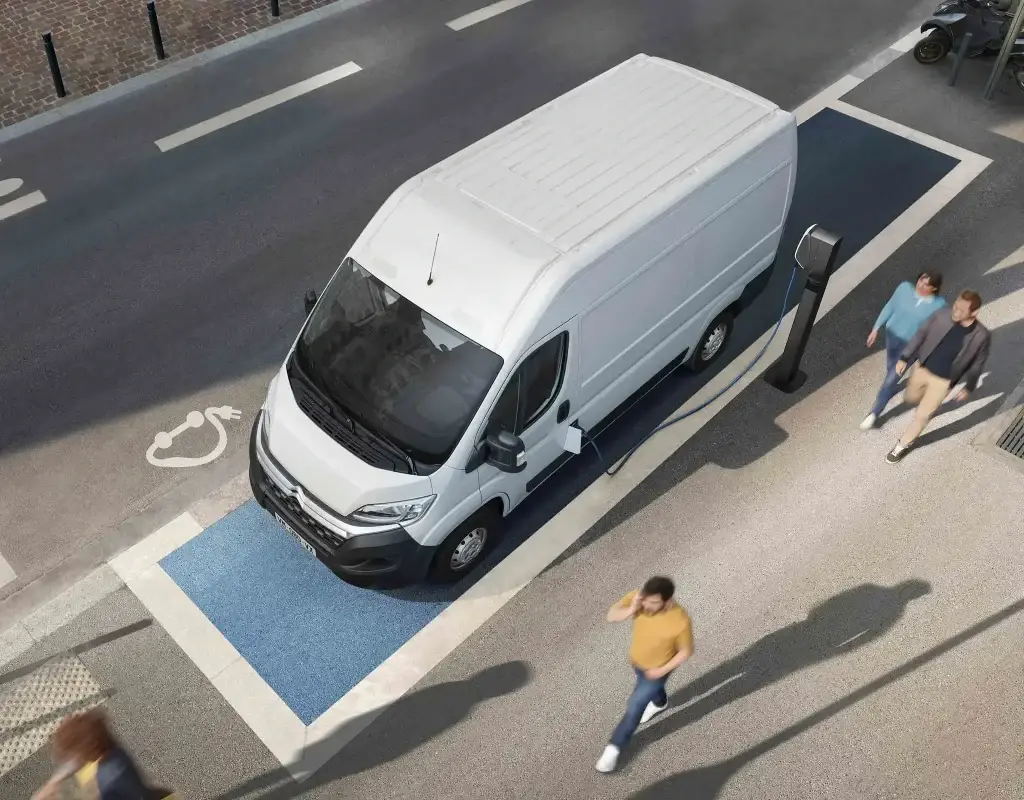Why choose an electric van for your business missions?
Reduced maintenance costs
With no conventional lubrication system, engine oil, particulate filter or air filter, an electric van has far fewer wear parts to manage. The regenerative brakingreduces wear on brake pads and discs. As a result, you reduce maintenance costs over the entire life of your car, and limit the risk of costly breakdowns.
Cost per kWh of electricity well below that of fossil fuels
In practice, electricity offers very competitive running costs: figures show that for 100 km, an electric vehicle can cost between 2 and €3compared with €6 to €8 (or even more, depending on the engine) for a thermal vehicle.
On a fleet with an average mileage of 15,000 km/year, the savings are substantial. So, even if there is an extra cost at the time of purchase, the financial advantages are often in favour of electric cars for intensive use.
Unlimited freedom of movement
With the tightening of regulations linked to the reduction of carbon emissions, many municipalities are introducing restrictive zones (ZFE, ZFE-m, ZCR, ZPA) in which the most polluting combustion-powered vehicles are banned. An electric van gives you sustainable access to the whole of the country, without constraints linked to classifications or time restrictions.
The roll-out of Low Emission Zones (ZFE) has been put on hold by political decisions following the vote by MEPs on 31 May 2025. However, air quality certificates (Crit'Air) and traffic restrictions during pollution peaks remain in force in many conurbations.
What economic and environmental advantages does an electric van offer?
Reduced TCO: a lever for optimising your fleet budget
A electric van consumes much less in use: the cost per kWh remains well below that of diesel or petrol. As mentioned above, maintenance is simplified (fewer wearing parts, regenerative braking, etc.).
Result: your total cost of ownership (TCO) is significantly lighter, making it possible to improve the financial management of your fleet and get a faster return on your investment.
Tax incentives not to be overlooked
The electric commercial vehicles can help you benefit from advantageous tax schemes:
- Exemption from company car tax (TVS) Since 2023, this has been replaced by two annual taxes (on CO₂ emissions and emissions of atmospheric pollutants), which will continue to apply to electric vans. exempt.
- Recovery of VAT For commercial vehicles, unlike passenger cars, VAT is generally charged on the purchase price. recoverableThis further reduces the real cost of acquisition.
These financial advantages make electric vehicles particularly attractive to fleet managers.
A choice consistent with your company's CSR strategy
Adopting an electric van also means reducecarbon footprint emissions: over its entire lifecycle, an electric vehicle emits 2 to 3 times less CO₂ than a combustion vehicle (figures ADEME).
This transition is part of the carbon neutrality and helps to reinforce the image of a responsible, innovative company committed to the energy transition. This sends a positive signal to your customers, partners and employees, demonstrating your active contribution to reducing emissions that are harmful to people and the environment.

How to assessautonomy and payload of an electric van to suit your needs?
Autonomy, a crucial criterion for professionals
With the democratisation of electric commercial vehicles (ECVs), technology has evolved considerably. Today, it's perfectly possible to have an electric commercial vehicle with sufficient autonomy for the majority of professionals' business needs.
Depending on the manufacturer and model, range is generally between 200 and 300 km. This means that daily urban journeys and delivery rounds can be covered without any major constraints.
Theoretical autonomy vs. real autonomy
The range claimed by manufacturers is often calculated under ideal conditions, using the WLTP (Worldwide Harmonized Light Vehicles Test Procedure). It corresponds to mainly urban journeys, with moderate temperatures and gentle driving.
In practice, several factors can reduce autonomy:
- Speed and type of road (motorway or city);
- Weather conditions (temperature, wind, rain, snow) ;
- The use of air conditioning or heating.
The weight carried and the vehicle's payload also have an impact on range.
Payload, a key factor
The payload is the maximum weight the vehicle can carry:
Payload (PL) = Gross vehicle weight - Unladen weight (UV)
It depends on your goods, the tools on board and the equipment being transported. For short journeys and light deliveries, a battery of 50 kWh may suffice. For larger catchment areas or heavier loads, opt for a higher-capacity battery (75 kWh or more).
Examples of models and their characteristics
| Model | WLTP range (km) | Battery capacity (kWh) | Beev catalogue price | Payload |
|---|---|---|---|---|
| Fiat E-Ducato | 283 km | 79 kWh | from 63,240 EXCLUDING VAT | to 1,9 T |
| Mercedes eSprinter Van | 153 km | 35 kWh | from 75,972 EXCLUDING VAT | 891 kg |
| Citroën ë-Berlingo Van | 275 km | 50 kWh | from 40,440 EXCLUDING VAT | 800 kg |
| Peugeot e-Expert | 230 km | 50 kWh | from 51,400 EXCLUDING VAT | to 1,2 T |
| Citroën e-Jumpy | 230 km | 50 kWh | from 40,500 EXCLUDING VAT | to 1,2 T |
What types of work are best suited to an electric van?
Electric vans are designed to meet the same requirements as combustion-powered vehiclesand can therefore be adapted to all types of professional assignments. The choice of model essentially depends on your specific needs in terms of load, volume and frequency of journeys.
Light commercial vehicles (LCVs)
LCVs are compact and manoeuvrable, perfect for transporting small quantities of goods over short distances. They are particularly well-suited to retailers, craftsmen or urban services who prefer a vehicle that is economical, easy to park and simple to use on a daily basis.
Minibus
Although often associated with passenger transport, the minibus can also be considered as a utility vehicle. It is ideal for public passenger transport These include company shuttles, tourist services and school transport.
Tipper truck
Mainly used in the construction and public works sectorthe tipper truck is equipped with a tipping trailer for rapid unloading of materials such as sand, gravel or site waste. It is ideal for building sites, landscaping and waste transport.
Utility van
The van is one of the most widely used vehicles in the transport and logistics. It is used for transport of goods over short and medium distances and is available in a range of sizes, from compact models to high-capacity vans for heavier loads.
Remember: you can always adapt an electric van with specific tools and equipment to suit your company's activity.
Converting your fleet to electric: the complete guide
How do you plan recharging and organise routes for an electric van?
For repeated short journeys
For urban tours or daily commutes, a recharge planner allows you to set the desired state of charge at your destination. Recharging can be automated, particularly during off-peak hoursto limit energy costs.
The use of route planning software optimises your supply chain from the warehouse to the last kilometre:
- Routes planned to minimise the number of kilometres travelled ;
- Maximising vehicle load factors ;
- Reduction in missed deliveries.
These tools also take into account local regulationsincluding Low Emission Zones (LEZ)They use precise geographical data to adjust speeds and routes, guaranteeing optimum productivity gains.
For long journeys
People often worry about long journeys in electric vans, often because they don't have enough recharging points. In reality, the network of charging points in France has grown significantly At 31 December 2024, there were 154,694 recharging pointsThis represents a year-on-year increase of 31 % (Avere barometer).
Effective planning allows you to minimise the time spent recharging. There are a number of applications that make this organisation easier :
- Chargemap, Nextcharge, Google Mapswhich locate the terminals on your route;
- Map showing the power of the terminals and their availability ;
- Information on free public charging points and user comments.
Some applications even allow you to filter terminals according to your needs. personal preferences type of badge, budget, power required, etc.
What are the maintenance and repair costs for an electric van?
Generally lower maintenance costs
For an electric commercial vehicle, it is essential to distinguish between ongoing maintenance costs from major repairs.
Routine costs include tyre changes, brake checks and electronic system checks. These services are less frequent and less costly than for a combustion vehicle, with estimated savings of between 20 and 30 %.
Good to know: the ZE (Zero Emission) revision
La ZE revision is specific to electric vehicles. It focuses on the electrical components: the state of health of the battery, the regenerative braking systems and the other components of the electrical system. This service is generally cheaper than that of a petrol vehicle, thanks to the reduced number of parts to be checked and the absence of an engine oil change.
Major repairs: a cost to be anticipated
Replacing the battery or electrical components may be necessary. more expensive On average, a repair to an electric vehicle costs 4 870 €against 3 973 € for a combustion-powered vehicle. To limit these costs, a regular and preventive maintenance is recommended.
Tips for maximising battery life
To protect your investment and extend the life of your battery :
- Load management Hold the battery between 20 % and 80 % of capacity; avoid frequent full loads or deep discharges.
- Charging rate : opt for slow, regular loads rather than fast and intense.
- Extreme temperatures Parking: park in the shade or in areas of moderate temperature.
Finally, the cumulative cost of maintaining and repairing an electric van is significantly lower than that of a combustion-powered vehicle, while guaranteeing greater reliability and peace of mind for your business operations.

What alternatives and complementary solutions to electric vans exist for urban delivery?
Alternatives for last-mile deliveries
To reducecarbon footprint and thespace requirement of commercial vehicles in town, a number of alternative solutions are being developed.
Le cargo bike is a particularly interesting option: it's a bicycle extended at the rear with a load-carrying device. Already used by a number of food delivery companies, it allows you to get around town quickly, often more efficiently than a motorised vehicle, while remaining environmentally friendly.
Scooters and other urban solutions
While cargo bikes have their limits in terms of speed and volume, electric scooters are better suited to faster deliveries.
At the same time, new delivery channels are emerging, specially designed for hard-to-reach urban areas, combining light mobility and route optimisation.
These solutions enable companies to cut costs, reduce their environmental impact and improve the flow of deliveries.
Switching to electric commercial vehicles is a strategic opportunity to reduce your costs, improve the reliability of your fleet and meet today's environmental challenges. With concrete savings on fuel, simplified maintenance and advantageous tax benefits, the return on investment is rapid.
But greening your fleet of vans is also a way of getting more out of your business. innovation and image. This approach positions your company as responsible, modern and committed to the energy transition.
Monday to Friday
9am - 12.30pm - 2pm - 7pm
































